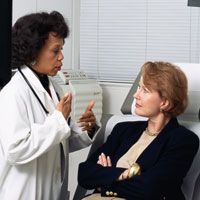Heart Disease Testing
What Every Woman Should Know

A woman in her 60s sought help from a cardiologist after experiencing chest pain. She had slightly high cholesterol and high blood pressure. But when her doctor performed an angiogram—the standard test for finding blockages in the heart’s major arteries—the results were normal.
Donald McElroy, MD, cardiologist at OSF Saint Francis Heart Hospital and HeartCare Midwest who consulted with the woman, could have sent her home with no worries. Instead, he suspected she might have coronary microvascular syndrome. This disease is difficult to diagnose because it occurs in blood vessels that are too small to be seen on an angiogram. He prescribed medication, and her pain lessened considerably.
“The important message is that a woman who does not have blockages in her major arteries can have chest pain,” said Dr. McElroy. “It is real. If you experience chest pain, see a doctor.”
Detecting Microvascular Disease
When the small arteries are involved, chest pain symptoms are felt due to abnormal constriction of these blood vessels. This reduces blood and oxygen supply to the heart, causing chest pain. And while most women with the condition don’t appear to be at higher risk for a heart attack, “Chest pain affects a woman’s quality of life and takes an emotional toll,” said Dr. McElroy.
Microvascular disease may be related to hormonal and metabolic changes and other risk factors unique to women. To check for the condition, your doctor first may order an exercise stress test to gauge blood flow during activity, said Dr. McElroy. An angiogram may follow. If no blockages in major arteries are found, your doctor may order additional tests.
Controlling Symptoms
The size and location of the blood vessels involved make interventions like balloon angioplasty and coronary artery bypass surgery impossible, Dr. McElroy said. So the firstline treatment for coronary microvascular disease is medication to relax the muscles of the heart and blood vessels.
Dr. McElroy also works closely with patients to reduce their risk for further heart problems. “Women with microvascular disease probably also have plaque building up in their major arteries,” he said. “It’s important that they stop smoking, keep their blood pressure and cholesterol levels in check, eat a heart-healthy diet and exercise regularly.”
OSF Saint Francis Heart Hospital invites you to bring your sweetheart or plan a girl’s night out for Embrace Your Heart and Engage Your Life on Tuesday, February 6, from 5:30 p.m. to 8 p.m. at the Par-A-Dice Hotel. Learn tips, strategies and get inspired for healthy and passionate lifestyles. To register call 1-888-6-ASK OSF. tpw
Donald McElroy, MD, cardiologist at OSF Saint Francis Heart Hospital and HeartCare Midwest who consulted with the woman, could have sent her home with no worries. Instead, he suspected she might have coronary microvascular syndrome. This disease is difficult to diagnose because it occurs in blood vessels that are too small to be seen on an angiogram. He prescribed medication, and her pain lessened considerably.
“The important message is that a woman who does not have blockages in her major arteries can have chest pain,” said Dr. McElroy. “It is real. If you experience chest pain, see a doctor.”
Detecting Microvascular Disease
When the small arteries are involved, chest pain symptoms are felt due to abnormal constriction of these blood vessels. This reduces blood and oxygen supply to the heart, causing chest pain. And while most women with the condition don’t appear to be at higher risk for a heart attack, “Chest pain affects a woman’s quality of life and takes an emotional toll,” said Dr. McElroy.
Microvascular disease may be related to hormonal and metabolic changes and other risk factors unique to women. To check for the condition, your doctor first may order an exercise stress test to gauge blood flow during activity, said Dr. McElroy. An angiogram may follow. If no blockages in major arteries are found, your doctor may order additional tests.
Controlling Symptoms
The size and location of the blood vessels involved make interventions like balloon angioplasty and coronary artery bypass surgery impossible, Dr. McElroy said. So the firstline treatment for coronary microvascular disease is medication to relax the muscles of the heart and blood vessels.
Dr. McElroy also works closely with patients to reduce their risk for further heart problems. “Women with microvascular disease probably also have plaque building up in their major arteries,” he said. “It’s important that they stop smoking, keep their blood pressure and cholesterol levels in check, eat a heart-healthy diet and exercise regularly.”
OSF Saint Francis Heart Hospital invites you to bring your sweetheart or plan a girl’s night out for Embrace Your Heart and Engage Your Life on Tuesday, February 6, from 5:30 p.m. to 8 p.m. at the Par-A-Dice Hotel. Learn tips, strategies and get inspired for healthy and passionate lifestyles. To register call 1-888-6-ASK OSF. tpw
